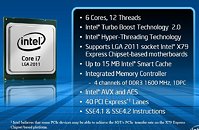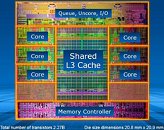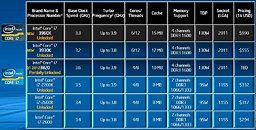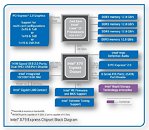Monday, November 14th 2011

Intel Releases Core i7 ''Sandy Bridge-E'' Processors
Intel today released its Core i7-3000 series processor family, codenamed "Sandy Bridge-E". These new processors, along with the new Intel X79 chipset, make up for an entirely new platform. The processors are an upscale of the Sandy Bridge architecture found on chips in the LGA1155 package. The Sandy Bridge-E silicon measures 20.8 x 20.9 mm, with a humungous transistor count of 2.27 billion. In its Core i7-3000 configuration, the silicon has up to 6 cores, up to 15 MB of L3 cache, four DDR3 memory channels, and 40 PCI-Express 3.0 lanes ("some" devices "may" support Gen 3.0, Intel's words).
Sandy Bridge-E has the same instruction set as Sandy Bridge, which includes SSE up to version 4.2, AVX, AES, and features Turbo Boost 2.0, HyperThreading. It's the memory controller that's complete upscale. It features four independent 64-bit paths to DDR3 DIMMs, making it a quad-channel DDR3 IMC. DDR3-1600 MHz is natively supported. There are three models, the Core i7-3960X Extreme Edition leads the pack with a clock speed of 3.30 GHz, 3.90 GHz top Turbo Boost speed, and 15 MB of L3 cache. It has 6 cores and 12 threads with HTT enabled. This chip has all its multipliers unlocked and is geared for overclocking. It is priced at US $990 in 1000 unit tray quantities, though retailers might draw a decent margin for the boxed parts.The next best chip in the series is Core i7-3930K. With clock speeds of 3.20 GHz and 3.80 GHz (Turbo), this chip has a slightly smaller L3 cache size of 12 MB, though it is still unlocked and geared for overclocking. Like the i7-3960X, this is a 6 core / 12 thread chip. This chip commands a price of $555. Touted to be the most affordable model, the Core i7-3820 is a quad-core part drawn out of disabling two cores (there's no evidence so far that they can be unlocked). With HTT enabled, this chip offers 8 threads. Its L3 cache is further reduced, to 10 MB (still higher than any preceding Core i7 quad-core model). Unfortunately, this chip is "partially unlocked", meaning that its base clock multiplier is locked, though you can still effectively overclock it by tinkering with the base clock. What's even more depressing is that this chip won't be available until Q1 2012. It is supposed to be priced in the $299~$399 range. This means that the only people building Sandy Bridge-E desktops this Christmas will be the ones with at least $600 to spare for a processor.
Moving on to the platform itself, the processor is built on the new LGA2011 package, it's the largest CPU package by dimensions, in recent times. Over its 2011 pins, the processor gives out four DDR3 memory channels and 40 PCI-Express 3.0 lanes, a DMI 4 GB/s connection to the X79 chipset, and a large number of pins handling power. The X79 chipset itself doesn't differ much from the P67 chipset in terms of the kind of connectivity it offers, except support for Intel Smart Response SSD-caching technology.
Sandy Bridge-E has the same instruction set as Sandy Bridge, which includes SSE up to version 4.2, AVX, AES, and features Turbo Boost 2.0, HyperThreading. It's the memory controller that's complete upscale. It features four independent 64-bit paths to DDR3 DIMMs, making it a quad-channel DDR3 IMC. DDR3-1600 MHz is natively supported. There are three models, the Core i7-3960X Extreme Edition leads the pack with a clock speed of 3.30 GHz, 3.90 GHz top Turbo Boost speed, and 15 MB of L3 cache. It has 6 cores and 12 threads with HTT enabled. This chip has all its multipliers unlocked and is geared for overclocking. It is priced at US $990 in 1000 unit tray quantities, though retailers might draw a decent margin for the boxed parts.The next best chip in the series is Core i7-3930K. With clock speeds of 3.20 GHz and 3.80 GHz (Turbo), this chip has a slightly smaller L3 cache size of 12 MB, though it is still unlocked and geared for overclocking. Like the i7-3960X, this is a 6 core / 12 thread chip. This chip commands a price of $555. Touted to be the most affordable model, the Core i7-3820 is a quad-core part drawn out of disabling two cores (there's no evidence so far that they can be unlocked). With HTT enabled, this chip offers 8 threads. Its L3 cache is further reduced, to 10 MB (still higher than any preceding Core i7 quad-core model). Unfortunately, this chip is "partially unlocked", meaning that its base clock multiplier is locked, though you can still effectively overclock it by tinkering with the base clock. What's even more depressing is that this chip won't be available until Q1 2012. It is supposed to be priced in the $299~$399 range. This means that the only people building Sandy Bridge-E desktops this Christmas will be the ones with at least $600 to spare for a processor.
Moving on to the platform itself, the processor is built on the new LGA2011 package, it's the largest CPU package by dimensions, in recent times. Over its 2011 pins, the processor gives out four DDR3 memory channels and 40 PCI-Express 3.0 lanes, a DMI 4 GB/s connection to the X79 chipset, and a large number of pins handling power. The X79 chipset itself doesn't differ much from the P67 chipset in terms of the kind of connectivity it offers, except support for Intel Smart Response SSD-caching technology.




81 Comments on Intel Releases Core i7 ''Sandy Bridge-E'' Processors
Damn I was looking forward to X79... Guess I'll have to wait? Damn this sucks ass
But prices are pretty good so far :)
Anand has a review up
www.anandtech.com/show/5091/intel-core-i7-3960x-sandy-bridge-e-review-keeping-the-high-end-alive
Fuck you Intel:ohwell:
I made more noises about it here.
www.microcenter.com/single_product_results.phtml?product_id=0376493
www.ncix.com/search/?categoryid=0&q=x79
259.99$, 279.99$, 299.99$... This is in CANADA where prices are usually a rip-off... and on LAUNCH DATE. Hope to see 250$ or less in the future :D
This is intel's bulldozer.
Heavily multi-threaded apps' performances are were they should be, at a 40%-50% increase over 2600k.
Intel did make a mistake if we look at it from a marketing pov, and they made it several months ago by releasing the midrange part first. Mid-range, in this consolized gaming market and lazy consumer app programers will always take the cake, specially when the difference is the number of cores. That's why everyone always try to release high-end first, even on GPUs which are always used to almost 100% of their potential.
Nothing too surprising, in multithreaded applications it takes off, in single-threaded application it's pretty terrible and the older Sandy Bridge come out ahead in a few instances.
When it comes to gaming it looks to be another Bulldozer, it's pretty underwhelming. It performs the same or a little worse in pretty much all titles against older chips.
The only time this chip is a good buy is if you have a lot of money to spend and you do a lot of heavy multithreaded work, that's where it seems to shine.(not surprisingly)